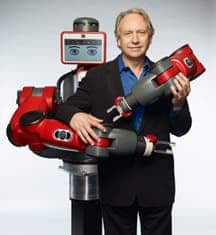
Rethink Robotics has been in the attention of the industry for a few years now since it was first founded by Rodney Brooks, possibly the most celebrated roboticist in the world, as the company promised from the get-go that they’re aiming to completely revolutionize the manufacturing industry. Bold claims, but giving the reputation of the people involved in the company as well as a US $62 million in funding from top-tier investors such as Bezos Expeditions and Charles River Ventures, these were heeded words.
Finally, Rethink Robotics unveiled their flagship product, and while it’s still way too early for a revolution to take place, we’re definitely intrigued, if not impressed. Meet Baxter, a friendly faced robot which is light, reliable, safe to work with and most of all dead cheap. Actually the latter sums the quintessence behind Rethink’s business model – robots so cheap, yet sturdy and reliable, that any manufacturing plant can afford. Not a bad idea, considering in the US alone there are 300,000 small and medium-sized manufacturers.
Heralded as a productivity booster, Baxter doesn’t resemble your typical industrial manufacturing robot. For one, its price tag is in the range of a medium-priced car at $22,000 doesn’t come no where near the six figures you need to reach out of your pocket for an assembly line automaton. Of course, there’s a trade off – your typical, expensive assembly line mechanical-limb robot is lighting fast, precise and relentless. Baxter is designed for small-scale applications, the kind of tasks humans find repetitive and, well, let’s say robotic and by taking charge of these tasks, Rethink promises a productivity increase to plant owners.

Most of all, however, Baxter is made to work with humans. Its double functioning LCD display acts like a mask for the robot, through which it can exhibit emotions – and his pretty flexible too. For instance, when he’s really got his work cut out for him, Baxter’s eyebrows arch high on his forehead and his hands gesticulate wildly. Also, the same display can be used by works or engineers as an interactive console where you can program Baxter for new tasks, without actually requiring any programming skills.
While the robot is extremely light, around 75 kilograms, and its two arms are extremely flexible and rather precise allowing for nice, fluid motions, Baxter is still limited, and indeed that may have been the point. Still, we like the concept of a friendly plant robot, and if Brooks and colleagues manage to convince manufacturing owners from around the country as well, then you might be seeing more of Baxter in the future.
ZME readers, what’s your take on this? Would you be OK with working side by side with Baxter?






